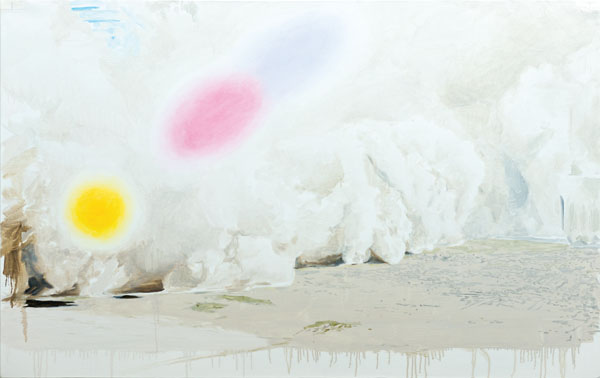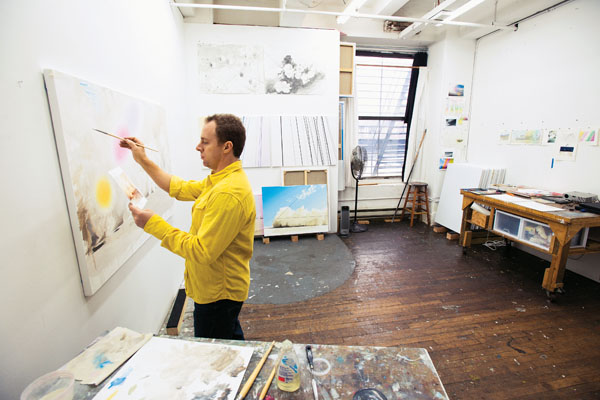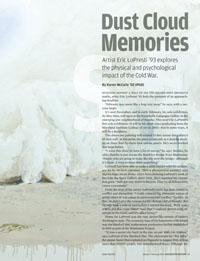Features
 DETAIL: From Dust Cloud mock-up. Dust clouds are “a way of talking about a dramatic, traumatic event,” says LoPresti. (Photo: Adam Fenster)
DETAIL: From Dust Cloud mock-up. Dust clouds are “a way of talking about a dramatic, traumatic event,” says LoPresti. (Photo: Adam Fenster)Standing against a wall of his 350-square-foot Brooklyn studio, artist Eric LoPresti ’93 feels the pressure of an approaching deadline.
“February may seem like a long way away,” he says, with a nervous laugh.
It’s mid-November, and in early February, his solo exhibition, No Blue Skies, will open at the Kunsthalle Galapagos Gallery in the emerging arts neighborhood of Dumbo. This won’t be LoPresti’s first solo exhibition—it will be his ninth since graduating from the Maryland Institute College of Art in 2002—but in some ways, it will be a departure.
The showcase painting will extend 15 feet across the gallery’s 25-foot wall. At this point, the piece exists only as a sketchy mock-up on three four-by-three-foot canvas panels. He’s never worked this large before.
“I want this show to have a lot of energy,” he says. Besides, he adds, Dumbo is just across the Brooklyn Bridge from Manhattan. “People who are going to make the trip over the bridge—although it’s short—I want to show them something.”
LoPresti has been able to make a solid impact with his customary 40-by-30-inch canvases. “He’s a phenomenal painter,” says Marisa Sage, an art dealer who’s been showing LoPresti’s work in her Like the Spice Gallery, since 2006. She’s watched his reputation grow. “He’s got very active collectors. They’ve all followed his career extensively.”
From the start of his career, LoPresti’s work has been rooted in conflict and disruption. “I really enjoyed big, cinematic scenes of aerial views of war zones or environmental conflict,” he says. At first, he didn’t give the reasons for his choices a lot of thought. But “it only took a year or two before I started thinking, ‘Well, wait, where did this come from?’ And then I realized there’s a big elephant in the room, and it’s called home.’”
Home for LoPresti was the vast, desert-like terrain of eastern Washington state. The economic base of his hometown of Richland was the Hanford Site, a plutonium production facility established in 1945 as part of the Manhattan Project.
“It was a secret city back in the day, on par with Los Alamos,” says LoPresti of the Hanford Site. The plutonium for “Fat Man,” the atomic bomb that exploded on Nagasaki in August 1945, killing more than 80,000 people, was manufactured there. Although the site had long ceased to be secret by the time the LoPrestis moved to Richland in 1980, “people didn’t talk a lot about Hanford’s main mission,” he says.
“Everyone’s parents worked on the site,” LoPresti recalls. His father was a statistician. “He never did weapons work. But he certainly had a lot of projects that he couldn’t talk about. There was this culture of ‘You don’t talk about what happens at work.’ ”
 AT WORK: LoPresti, working off a letter-sized watercolor to produce a canvas mock-up of Dust Cloud, estimates it will take him “about a month-and-a-half” of daily work to complete the painting that will extend 15 feet across. (Photo: Adam Fenster)
AT WORK: LoPresti, working off a letter-sized watercolor to produce a canvas mock-up of Dust Cloud, estimates it will take him “about a month-and-a-half” of daily work to complete the painting that will extend 15 feet across. (Photo: Adam Fenster)LoPresti also imbibed the power of the natural landscape. “My aesthetics were really formed when I was living in the desert,” he says, referring to the treeless stretches of dry land on the Columbia River Plateau, where Richland lies. He says the land can seem desolate—“blank,” even—to people unfamiliar with the region. But LoPresti sees color everywhere. Not bright color, but dramatic, striking color nonetheless.
“The color’s very subtle, and you have to kind of be tuned in to the misty sort of pinks, browns, and yellows,” he says. In one series of paintings, he depicts aerial views of the Hanford site, at different points throughout its history, with those misty desert hues superimposed.
In 2010, LoPresti returned to Washington for the opening of a solo show called Afterglow. A dual-venue exhibit, it took place at both Washington State University Tri-Cities and the Richland Public Library. Joining him at the opening was Richard Rhodes, author of the Pulitzer Prize–winning The Making of the Atomic Bomb, and in 2010, The Twilight of the Bombs. In a joint lecture, the two discussed the impact of the Hanford Site on the physical and moral landscape of the region.
“Richard’s participation in Afterglow meant an enormous amount to me,” LoPresti says. “He takes on the darkest subjects, but with the empathy of a novelist. As we spoke, I realized that it wasn’t outrageous for me to connect my own small story to the enormous subject of thermonuclear war. It was, in fact, essential to who I was trying to become as an artist. “We still live in the aftermath of near global annihilation. My hometown happens to be one of those places where you can see that brush with apocalypse written directly on the desert landscape.”
In another series of works, which will be shown later in 2013 at the National Atomic Testing Museum in Las Vegas, an affiliate of the Smithsonian Institution, LoPresti depicts aerial views of the Nevada test site, the crater-laden expanse whose visual scars are reminders of its role as the nation’s primary nuclear test site throughout the Cold War.
At the Kunsthalle Galapagos, the centerpiece painting will be called Dust Cloud, named for the theme that will unite the works in the exhibit.
“This is the source image,” he says, approaching a small photograph tacked to the wall opposite where the mock-up now hangs. A still photograph from a video taken by a soldier in Iraq, it’s situated in a row of images, paper sketches, and notes. LoPresti explains that this particular dust cloud was produced by a helicopter landing. But that’s incidental. What he really wants to explore is the cloud itself.
“It’s a little more abstract than my previous work,” he says. “It’s not really clear that it’s in Iraq, it’s not really clear what made the dust cloud. It could represent a lot more things. And for me that's what the dust metaphor starts to be. It's a way of talking about a dramatic, traumatic event.”
Coincidentally, on the previous evening, LoPresti had watched the first segment of Ken Burns’s documentary, The Dust Bowl, which aired over two evenings last fall on PBS.
“It’s just apropos,” LoPresti says of the documentary. He notes that there have been several iconic dust clouds in modern memory in the United State alone. Following the disastrous dust storms of the 1930s was what LoPresti calls “the biggest of them all,” the mushroom cloud of Alamagordo. On September 11, 2001, there was the roaring, black cloud that rolled up Broadway as the Twin Towers fell. And LoPresti points to another iconic dust cloud, which he says looms largest in his own memory: the cloud produced by the explosion of the space shuttle Challenger in January 1986, which sent brilliant white streams spewing across a blue sky like fireworks. “I think if I showed you a little image of that cloud, you would recognize it immediately,” he says.
A collaborative team of artists and curators decides on exhibits at the Kunsthalle Galapagos. Julie McKim, the gallery’s director, who has also worked at the Whitney Museum of American Art and The Kitchen, says the team was united in its enthusiasm for LoPresti’s work. “Eric has something we like, which is that he’s conceptually strong and technically strong as well.”
LoPresti says his technical skills came first, while his conceptual framework developed slowly, both during and after graduate school. “I wasn’t raised an artist,” he says, though he credits his mother, who attended art school briefly, as his first teacher. “I was a science kid.”
LoPresti’s high school chemistry teacher, Leo Faddis, nominated him for Rochester’s Bausch & Lomb scholarship. LoPresti didn’t even know it; and then he won. He remains grateful to this day for the one-handed teacher (“he’d blown his hand off in a chemistry experiment,” LoPresti explains, with some fascination) who had acted on his behalf.
“I had a really great experience at Rochester,” he says. “It really changed my life.” While majoring in brain and cognitive sciences, the student who’d always drawn and painted as a hobby ventured into the studio arts department seeking electives. He met Allen Topolski, the sculptor who’s long served as the chair of Rochester’s studio arts department and its principal undergraduate advisor. Topolski became a mentor, and LoPresti credits Topolski with helping him gain admittance to graduate school at the Maryland Institute College of Art—despite lacking the academic grounding in art, not to mention the extensive portfolio typical of most of those who are admitted to the institute’s master of fine arts program.
LoPresti never lost his love of science, and often reflects on his dual interests. “I wanted to be a scientist, but I also wanted to do both,” he says. After a couple of years of steady, secure work at the Pacific Northwest National Laboratory, “I decided I was going to throw myself into the thing that I knew less about.”
It was a risky move. It frightened and thrilled him at the same time. And it befits the man now standing before the Dust Cloud mock-up.
LoPresti says he wants his work to evoke a certain kind of feeling. “Maybe an example would be, if you were at the edge of a diving board and looked down. And maybe on the high dive it’s a little higher perhaps than you expected to go. It’s sort of excitement and fear at the same time. I like that feeling. And I want my paintings to have something about that in them.”

